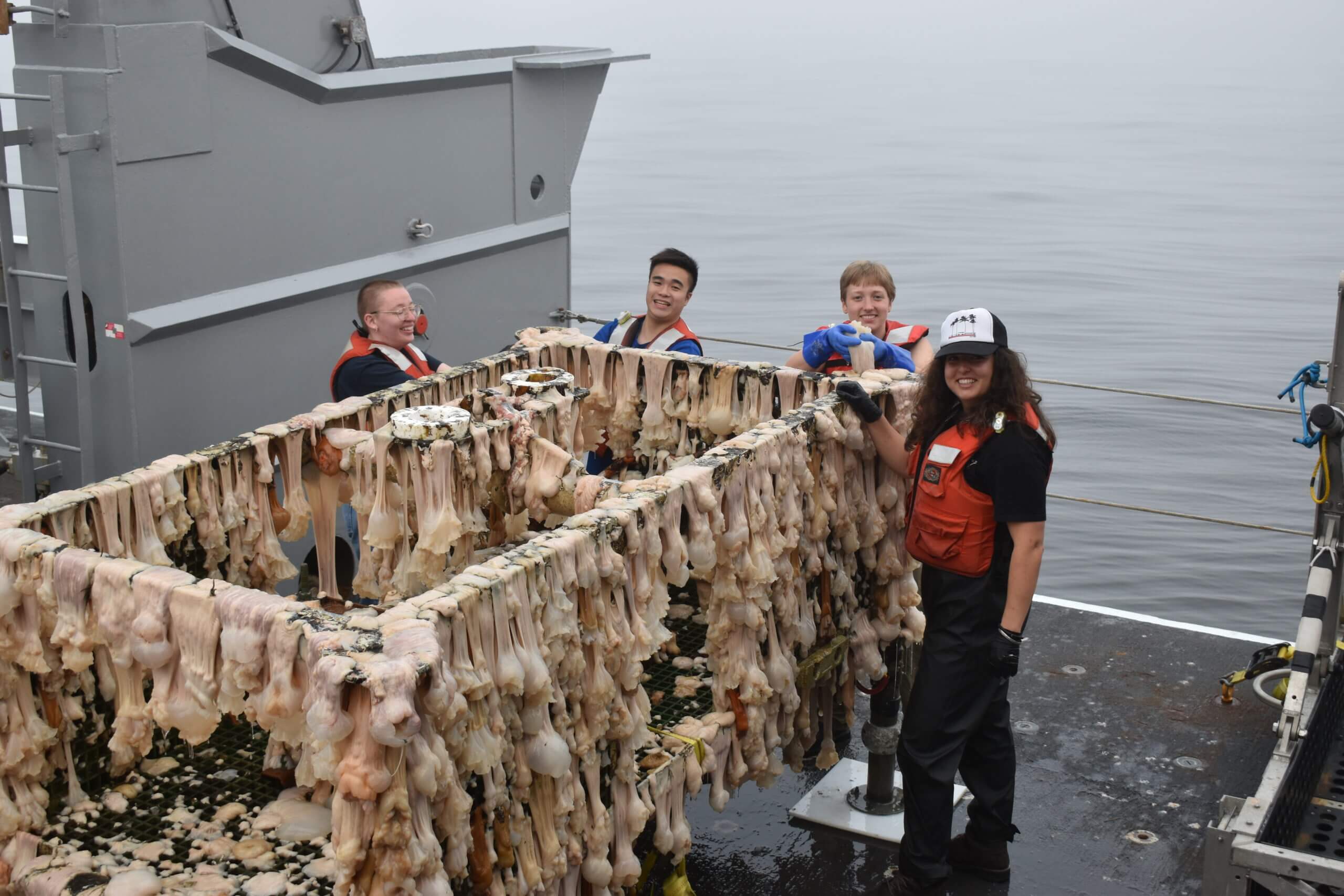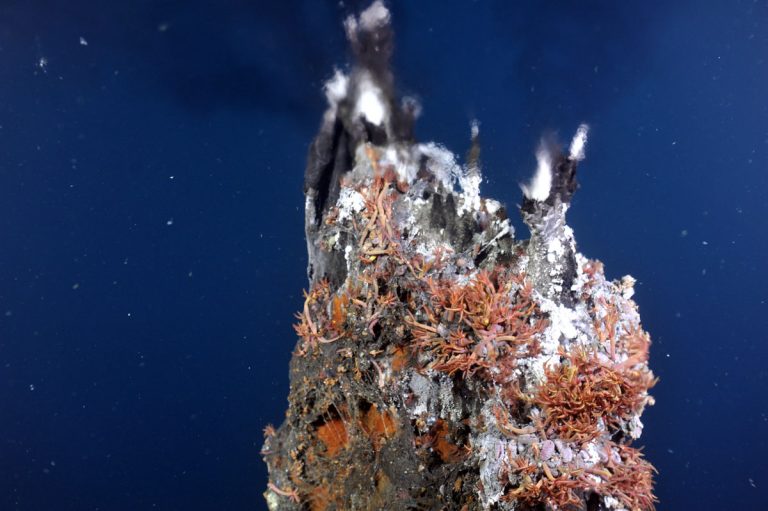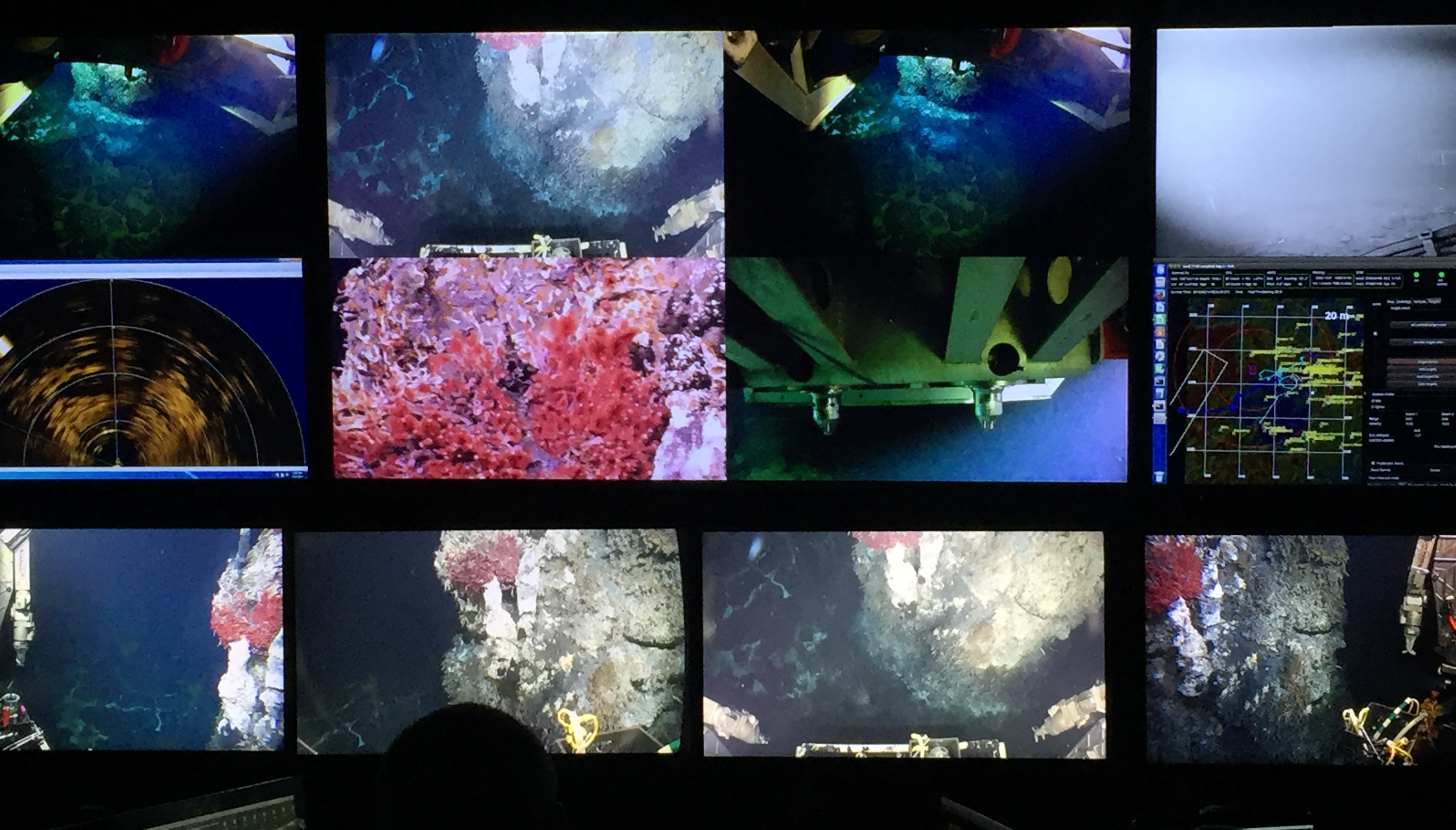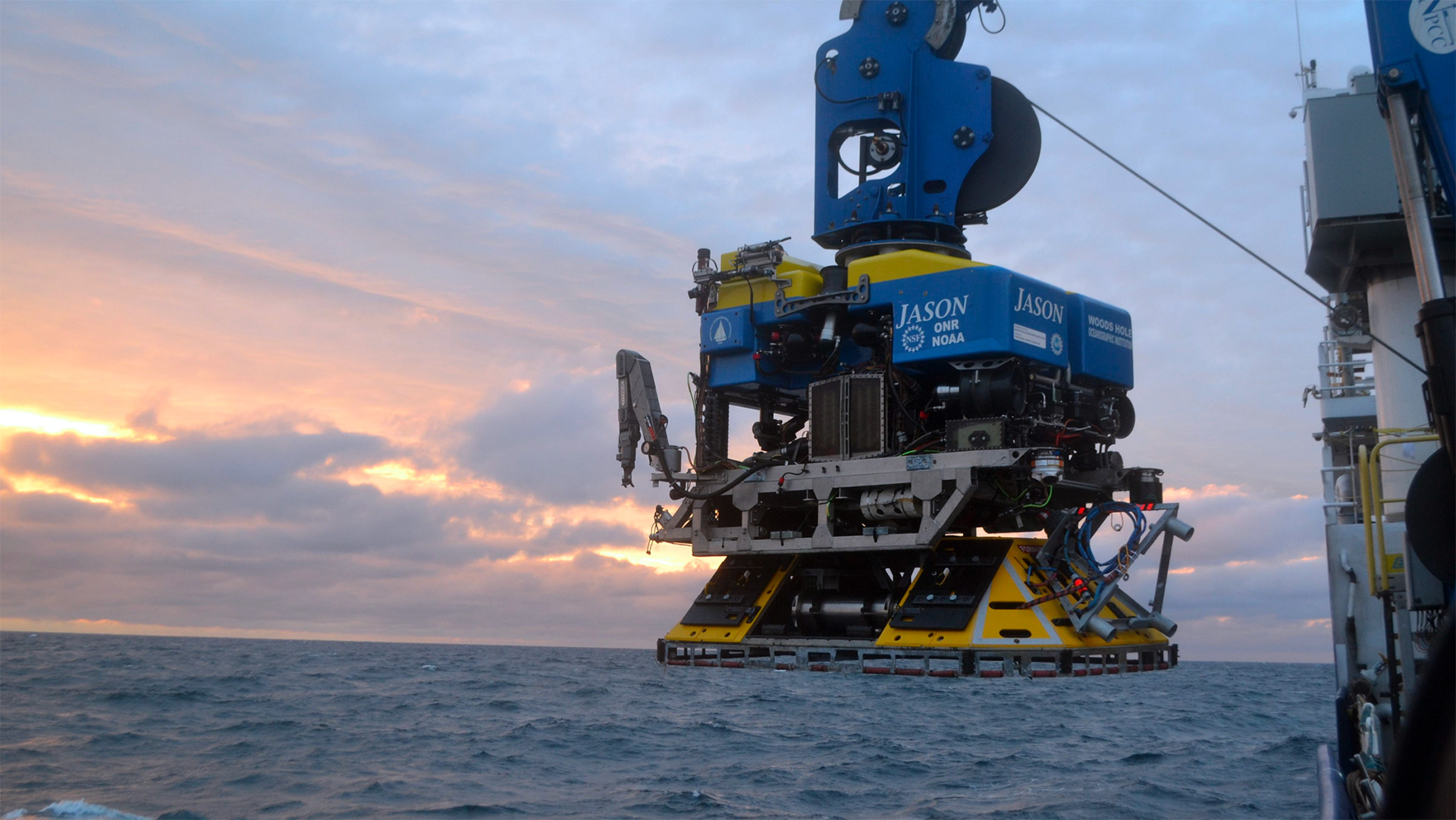Posts by Debbie Kelley
RCA Recording Swarm of Earthquakes in Real Time
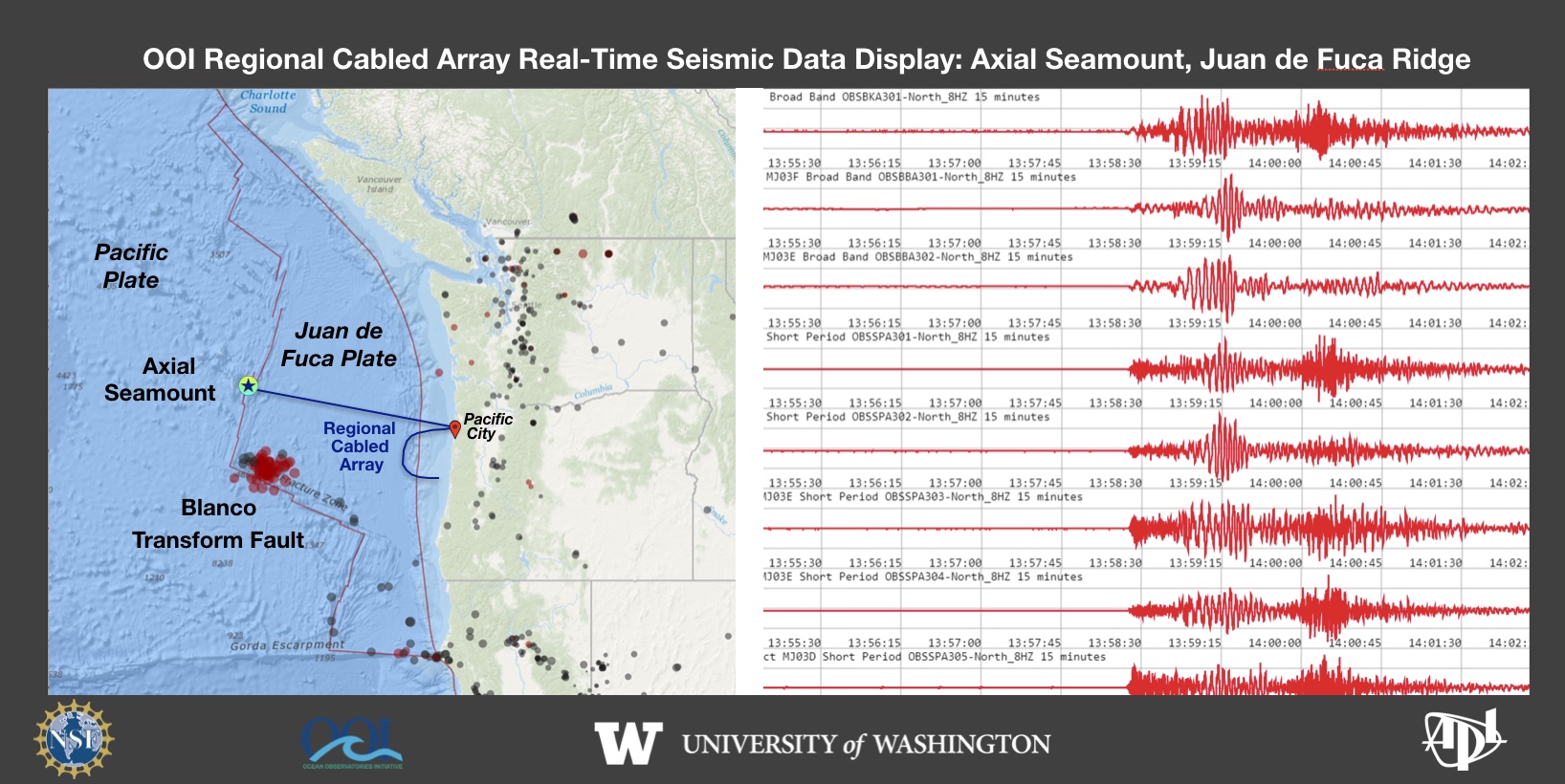 On December 7, 2021 a swarm of earthquakes began on the Blanco Transform Fault, a major plate boundary at the southern end of the Juan de Fuca Plate. The ongoing seismic swarm is being tracked live by the National Science Foundation’s underwater observatory, the Regional Cabled Array (RCA). The RCA is a component of NSF’s Ocean Observatories Initiative and is operated and maintained by the University of Washington. It includes ~900 km of high power and high bandwidth submarine fiber optic cables that stretch from Pacific City, OR out to the most active volcano off the coast “Axial Seamount” that erupted in 1998, 2011 and again in 2015. A second cable heads south along the Cascadia Subduction Zone and turns east along the Cascadia Margin off Newport, OR. Over 150 instruments on the seafloor and on instrumented moorings provide real-time data flow to shore at the speed of light. A suite of seismometers at the summit of Axial Seamount lit up on December 7, 2021 as the seismic swarm began along the Blanco. This live feed was developed by the UW Applied Physics Laboratory.
On December 7, 2021 a swarm of earthquakes began on the Blanco Transform Fault, a major plate boundary at the southern end of the Juan de Fuca Plate. The ongoing seismic swarm is being tracked live by the National Science Foundation’s underwater observatory, the Regional Cabled Array (RCA). The RCA is a component of NSF’s Ocean Observatories Initiative and is operated and maintained by the University of Washington. It includes ~900 km of high power and high bandwidth submarine fiber optic cables that stretch from Pacific City, OR out to the most active volcano off the coast “Axial Seamount” that erupted in 1998, 2011 and again in 2015. A second cable heads south along the Cascadia Subduction Zone and turns east along the Cascadia Margin off Newport, OR. Over 150 instruments on the seafloor and on instrumented moorings provide real-time data flow to shore at the speed of light. A suite of seismometers at the summit of Axial Seamount lit up on December 7, 2021 as the seismic swarm began along the Blanco. This live feed was developed by the UW Applied Physics Laboratory.
Read More
37-day RCA Cruise Met All Objectives and More
This summers’ Regional Cabled Array (RCA) 37-day expedition was one of the most complex of the seven annual Operations and Maintenance cruises to date. Not only was the expedition impacted by COVID restrictions, but it also included four Legs, a full contingent of engineers, scientists, students, and the Jason team, as well as coordinated ship operations with the R/V Thompson, the IT Integrity cable support ship, and the Ocean Exploration Trust ship the E/V Nautilus. However, thanks to the hard work of the RCA staff, and amazing support from the R/V Thompson (Captain Dave Vander Hoek) and ROV Jason teams, (Expedition Leads Ben Tradd and Mario Fernandez) the expedition was highly successful with the completion of all scheduled tasks…and more.
The expedition was led by Chief Scientists Mike Vardaro (Leg 1) and Orest Kawka (Legs 2-4), and Co-Chief Scientists James Tilley (Legs 1-3), Wendi Ruef (Leg 1 – this was the first time Ruef has sailed as a Co-Chief Scientist), Mike Vardaro (Leg 2), and Katie Bigham (Leg 4). Katie will receive her Ph.D. in 2022 from the University of Wellington, NZ. This cruise provided her a strong early career foundation for becoming a future Chief Scientist. James Tilley was the lead engineer and Larry Nielson led shore support.
COVID safety protocols significantly increased cruise complexities, which included the verification of full COVID vaccination status for all ship and science party members, ensuring that all participants sheltered-in-place, and the arrangement of COVID tests spanning both Washington and Oregon testing sites. The RCA team is highly appreciative of the exceptional support that the UW Marine Operations group provided to ensure our safety, the dynamics of crew changes, and modification of dock-side logistics in response to IT Integrity and E/V Nautilus operations.
[media-caption path=”https://oceanobservatories.org/wp-content/uploads/2021/09/PD01A_20210821_084428_recovery-scaled-1.jpeg” link=”#”]The Slope Base Deep Profiler Mooring comes aboard the R/V Thompson. Credit: M. Elend, University of Washington, V21. [/media-caption]Highlights: During the four Legs, just over 200 RCA Core and PI instruments were recovered/deployed, the Platform Interface Assemblies and Science pods on all three Shallow Profiler Moorings were turned, Deep Profiler vehicles were turned at the Oregon Offshore and Axial Base sites, and the Deep Profiler mooring was turned at Slope Base. Of particular note, the southern cable line was repaired, resulting in the return of full operational status for Primary Nodes PN1C and PN1D, providing communications and data flow once again to/from the Oregon Offshore and Shelf sites.
Over the 37 days of staging, mobilization, and demobilization for the four Legs, twenty 48 ft trailers transported 394,000 pounds of RCA equipment to and from Seattle, WA and Newport, OR. Onboard staffing included twenty-one RCA scientists and engineers, 13 ROV Jason crew, 16 students, 1 postdoc, and an artist, as well as two research scientists. During the 30 at-sea days, including two to aid in the recovery of the Ocean Exploration Trust ROV Hercules and Argus vehicle from the Endeavour Segment of the Juan de Fuca Ridge, the R/V Thompson transited ~1775 miles, 49 Jason dives were completed traversing a total of~ 125,000 meters of the water column, seven CTD casts with water sampling were completed spanning maximum cast depths of 200 m to ~ 2900 m, and two EM302 bubble plume surveys were conducted over methane seep sites at Southern Hydrate Ridge and Pythias Oasis. Finally, a new, highly active methane seep area was discovered east of the novel Pythias Oasis vent site, which has been continuously venting since its discovery in 2014.
PN1B: During Legs 1 and 2, significant and dynamic coordination was required to ensure that the R/V Thompson and C/S Integrity operations (lead by APL Engineer Chuck McGuire) were tightly coupled and that shore cranes and trucks were in place for mobilization and demobilization of both the RCA cruise gear and that associated with the recovery-repair of Primary Node PN1B. Three dives (August 5: J2-1342, and August 10-11: J2- 1342, and J2-1354) were dedicated to disconnection of cables, preparation of PN1B for recovery, and recovery of a ½ frame deployed by the Integrity, which was utilized for installation of the recovery line. The R/V Thompson-ROV Jason operations went well. Although the replacement PN1B installation could not be completed, the cable Segments 2-3 were joined and then successfully installed on August 23 – reinstating power and communications to Primary Nodes PN1C and PN1D. Unfortunately, the Southern Hydrate Ridge site will remain offline until next year, when PN1B can be reinstalled. However, joining of the segments allowed 76% of the instruments to go live again that had been offline since August 2020, as well as the Shallow Profiler and Deep Profiler moorings and BEP at the Oregon Offshore site, and the BEP and other seafloor instruments at the Oregon Shelf site.
VISIONS’21: Once again, live streaming of video and updates on the cruise were provided on the interactiveoceans website as part of the UW- RCA VISIONS’21 engagement efforts and highlights were provided on Instagram and Twitter. The 16 undergraduates that participated on the cruise worked four-hour shifts in the ROV control van, they learned how to process and analyze CTD samples, and they helped with cleaning of recovered RCA equipment (a big hit). Their enthusiasm permeated the team and their hard work contributed significantly to the cruise. We were grateful to have a resident watercolor artist onboard who shared aspects of the cruise and seafloor and biological observations through her eyes. The students shared their experiences through blogs and for many it changed their lives – a few examples of their impressions:
I found this to be a once in a lifetime opportunity and [it] offered me a broader perspective of how much preparation and consideration goes into the planning and execution of the research projects being facilitated through the OOI VISION’s expedition. It opened my eyes to the full circle of science.
This has truly been one of the coolest experiences I’ve had …. after 4 quarters of zoom classes and online labs, I’ve been so happy to finally get a feel for oceanographic research out in the field and to work with the instruments I’ve been learning about for a year and a half.
As a kid, I watched documentaries about the deep sea and imagined myself descending into the depths with the camera, sometimes sitting in a cardboard box “submarine” that I made. Being here and getting to work in the Jason van feels like accomplishing some part of that dream, and I’m very grateful to have had the opportunity to come on this trip. I’ve also come away with a better idea of how data are collected at sea, and in speaking with the scientists onboard I’ve gained a better understanding of how one goes about getting into the field.
Externally Funded Projects: The 2021 program was also another successful field season for turning, and installation, and recovery of instrumentation, and for science programs funded outside of OOI. This work included:
- The turning of NSF-funded CTDs at the ASHES hydrothermal field and at the Eastern Caldera sites, as well as installation of a new CTD at Central Caldera at the summit of Axial Seamount (W. Chadwick, Oregon State University – OCE 1928282 “Phase 2 of Enhancements to the OOI Cabled Array at Axial Seamount”). [1-day]
- The reinstallation of the University of Bremen-Germany-funded cabled overview multibeam sonar for imaging of all methane plumes at Southern Hydrate Ridge (G. Bohrmann and Y. Marcon -University of Bremen – Sonar monitoring of natural release of methane greenhouse gas from the seafloor – A contribution to the understanding of global change), the 4K camera, and turning of a CTD. [1-day]
- Installation of an NSF-funded new Pinnacle ADCP at the Central Caldera site to provide, for the first real-time, monitoring of currents throughout the entire ~1500 m water column (D. Manalang and D. Kelley, University of Washington – OCE 2129943 “RAPID: OOI-Industry Partnership to Install a Cabled 45 kHz ADCP at Axial Seamount Caldera”). This effort is in partnership with Teledyne Marine.
- Recovery of a NSF-funded self-calibrating pressure sensor at the geodetic-focused Central Caldera site (William Wilcock, University of Washington – OCE 1634103 – “A Rotating Tiltmeter for Marine Geodesy: Development and Testing at Axial Seamount on the Ocean Observatories Initiative Cabled Array”).
- A NSF-funded dive to complete site characterization, based on an ~ 1 m resolution bathymetry Sentry map, of the Pythias Oasis ridge. The dive focused on a “gully” that runs parallel to the ridge and s significant depression at the termination of the ridge (D. Kelley, University of Washington – OCE 1658201 “Collaborative Research: Pythia’s Oasis – Access to Deep Subduction Zone Fluids”). Pythias Oasis is venting fluids unlike any yet discovered in the world’s oceans. They are likely sourced at/near the plate boundary. Evidence of additional sites of seepage were discovered. [1-day]
- Three dives funded by the Bureau of Ocean Energy Management (D. Kelley, University of Washington – M21AC00009-00 “Arctic Marine Mineral Exploration – Ramen Laser Spectroscopy Validation”) at the ASHES hydrothermal field in support of the NASA InVADER program. Major and gas-tight vent fluids and several sulfide samples were recovered, and a couple microbial incubation experiments were deployed [1-day].
Recovery of the ROV Hercules and Argus Vehicle: On August 26th, the Ocean Exploration Trust ROVs Hercules and Argus became detached from the tether on the E/V Nautilus working east of the Main Endeavour Field (MEF) on the Endeavour Segment of the Juan de Fuca Ridge (2220 m). After a flurry of phone calls and Zoom meetings, the R/V Thompson, RCA, and OET (Expedition Lead Allison Fundis) teams came together for a community effort to recover the vehicles. The R/V Thompson transited ~ 10 hrs north to the MEF where there were two Jason dives to facilitate the September 2 successful recovery of the vehicles back onboard the E/V Nautilus. The effort required extension of the RCA cruise by two days, and it was a weary team that pulled back into Newport on September 3. Demobilization was complete on September 4th.
Read More
RCA Visions 21 Departs for 37-day Expedition
The University of Washington Regional Cabled Array Team left Seattle, Washington on 30 July for its annual Operations and Maintenance (O&M) Expedition for the cabled component of the National Science Foundations’ Ocean Observatories Initiative (OOI), through September 4, 2021. This 37-day cruise is on the global class research ship the R/V Thomas G. Thompson, operated by the University of Washington, which is hosting the remotely operated vehicle (ROV) Jason, operated by Woods Hole Oceanographic Institution.
[media-caption path="https://oceanobservatories.org/wp-content/uploads/2021/07/J1265_20200808_0232_CAMDSB303_recover-copy-2.jpeg" link="#"]ROV Jason breaks the surface above the most active volcano off the WA-OR coast. Credit: UW/NSF-OOI/WHOI. V20.[/media-caption]The expedition can be followed through live video feeds from sea, daily updates, and stunning imagery. During the cruise, virtual visitors will be able to directly observe parts of the seafloor rarely seen by humans – the most active submarine volcano off our coast ‘Axial Seamount’ located about 300 miles offshore and nearly a mile beneath the oceans’ surface. Here virtual visitors can witness one of the most extreme environments on Earth – underwater 700°F hot springs teaming with life that thrives on volcanic gases and lives in the complete darkness of the deep sea. The team will also visit the Cascadia Margin, spending time at Southern Hydrate Ridge where methane ice deposits are exposed on the seafloor with areas of dense microbial mats, and at shallower sites that are some of the most biologically productive areas in the world’s ocean.
[media-caption path="https://oceanobservatories.org/wp-content/uploads/2021/07/overview.flow_.mosquito.sm_.r1772_03229-scaled.jpg" link="#"]A “Mosquito” flow meter (far left) and osmotic fluid sampler (far right) installed on microbial mats Southern Hydrate Ridge. Photo credit: NSF-OOI/UW/CSSF; Dive R1772; V14.[/media-caption]The Regional Cabled Array (RCA) team is excited to get underway and looking forward to being out in the Pacific Ocean again. This is an immense logistics operation with ~ 20 trucks transporting >130,000 lbs of gear to Newport, Oregon in support of highly complex at-sea operations that have required months of planning, and testing of gear to be installed. During the cruise, the ROV will deploy and recover a diverse array of more than 200 instruments, several small seafloor substations that provide power and communications to instruments on the seafloor and on moorings that span depths of 2900 m (9500 ft) to 80 m (260 ft) beneath the oceans’ surface. In addition, several novel, externally funded instruments developed by scientists in the US and Germany will be installed.
This year, the RCA Team will be joined by 19 students sailing as part of the UW’s educational mission (VISIONS’21). The students will be distributed over the four legs of the O&M Expedition. The VISIONS program has allowed >160 students to participate in this at-sea experiential learning program.
Virtual visitors will have the opportunity to share in the students’ wonder and excitement through their blogs and daily updates here. Be sure to bookmark this site and check back often to share in what promises to be a life-changing experience for many students. Share in their adventure!
Article by Deb Kelley, Principal Investigator for the Regional Cabled Array
Read MoreCommunity Expansion of the Regional Cabled Array
In 2016, the National Science Foundation (NSF) opened up opportunities for the community to submit proposals to add infrastructure/instrumentation onto the Ocean Observatories Initiative (OOI) marine facility and to use OOI data for research and educational purposes. Following this call, there was a rapid response from researchers to expand the Regional Cabled Array (RCA) with additional funding from the Office of Naval Research (ONR), NASA, and the international community. As of 2021, over $36M has been awarded from these sources for research and education associated with the RCA. Sixty-five awards have been made to 66 Principal Investigators (PI) and Co-PIs representing 32 institutions and 2 industry partners.
Axial Seamount: A Hot Bed of Research
Axial Seamount is the most advanced submarine volcanic observatory in the oceans and has been the focus of numerous awards with a diverse funding portfolio. Infrastructure within the caldera currently includes 21 core instruments, funded through the OOI, and 8 PI instruments now installed and another 4 to be installed in 2021-2022. In concert, this instrumentation is yielding new insights into the dynamics of Axial Seamount’s magmatic system, diking-eruptive events, and linkages among seismic, hydrothermal, and chemical processes; and is providing the first forecasting capabilities on when this highly active volcano will erupt again.
Central Caldera
[caption id="attachment_20234" align="alignleft" width="300"]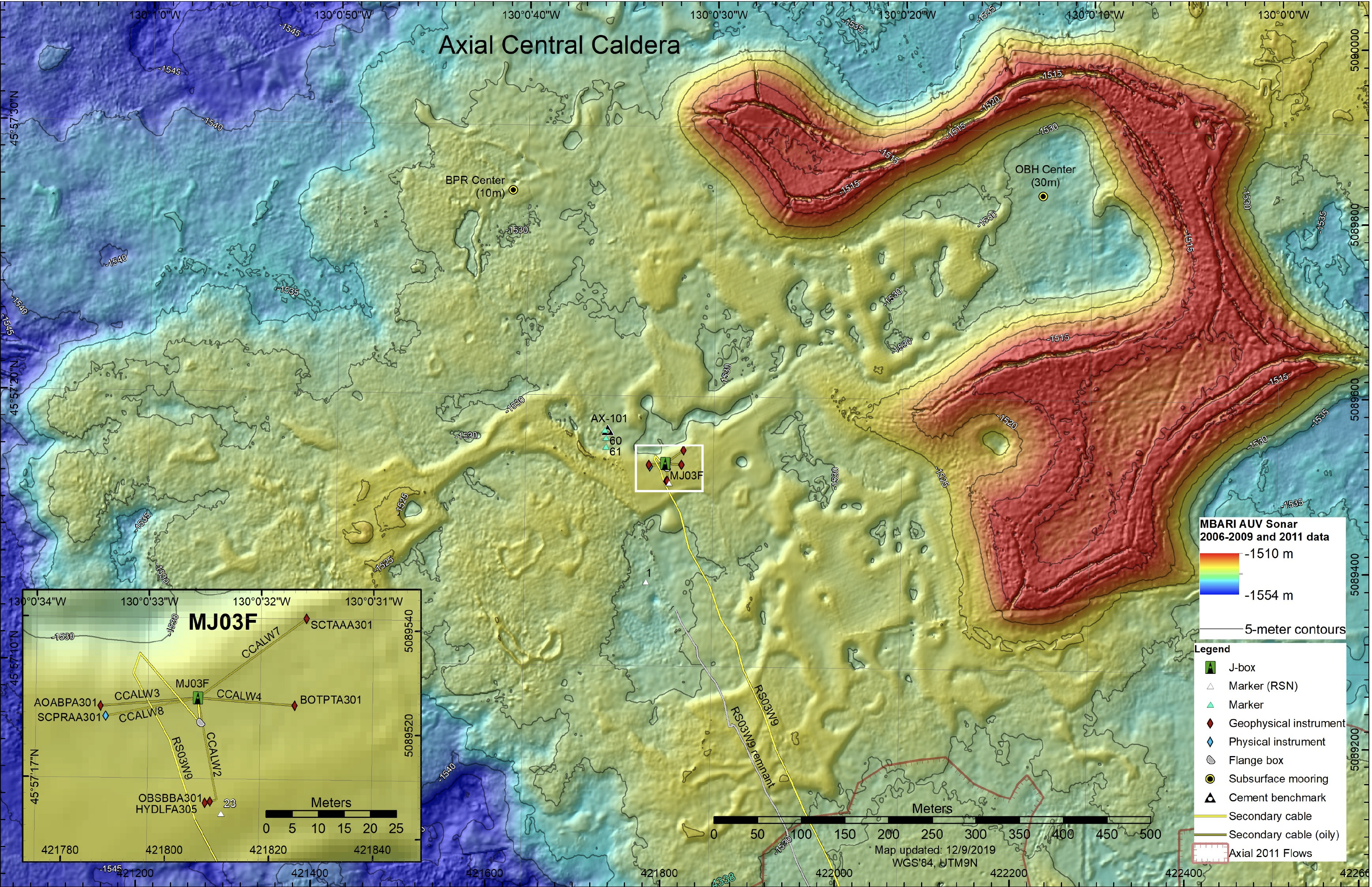 RCA infrastructure and NSF-funded PI instruments at Central Caldera as deployed in 2019. Credit: University of Washington.[/caption]
RCA infrastructure and NSF-funded PI instruments at Central Caldera as deployed in 2019. Credit: University of Washington.[/caption]
At the summit of Axial, the Central Caldera site has become an important research site for development and testing of geophysical instruments with focus on geodetic applications. RCA core instruments at this site include a bottom pressure-tilt instrument, a broadband seismometer and low frequency hydrophone. Here, three novel PI instruments, funded by the NSF, measure vertical changes in the seafloor at high resolution with removal of drift in pressure measurements.
These instruments include: 1) a Self-Calibrating Pressure (SCPR) recorder using an internal drift free pressure reference (Drs. M. Zumberge and G. Sasagawa, Scripps Institution of Oceanography), which was installed in 2018 with data now available through OOI;
[caption id="attachment_20232" align="alignright" width="300"]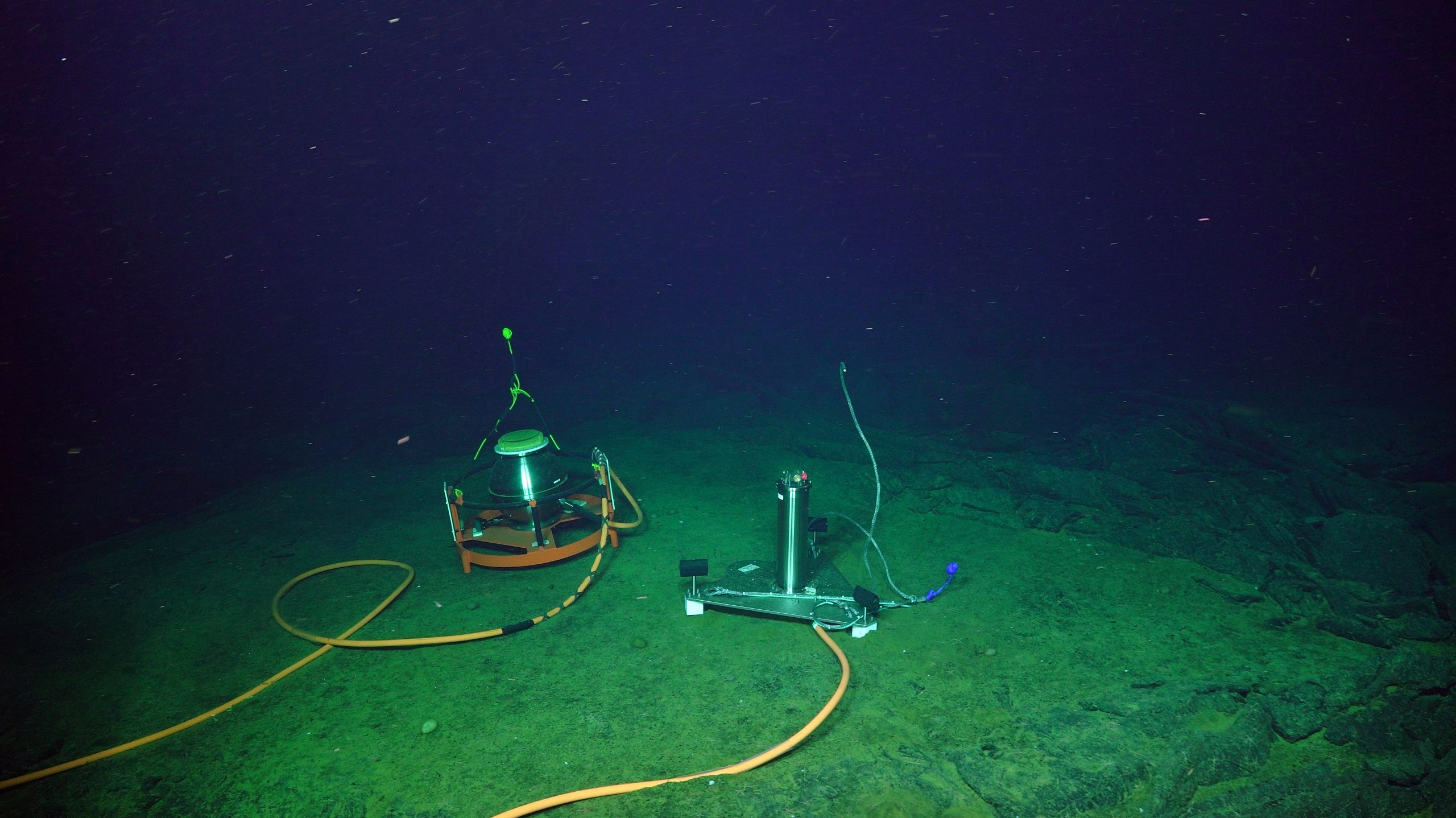 The Self-Calibrating Pressure Recorder (left) sits adjacent to the A-O-A instrument allowing cross comparison of data focused on seafloor deformation. Credit: UW/NSF-OOI/WHOI; V19.[/caption]
The Self-Calibrating Pressure Recorder (left) sits adjacent to the A-O-A instrument allowing cross comparison of data focused on seafloor deformation. Credit: UW/NSF-OOI/WHOI; V19.[/caption]
2) a flipping tilt meter (SCTAA) (Dr. W. Wilcock, University of Washington) installed in 2018 that corrects for instrument drift by calibrating the sensor against the Earth’s gravitational force using a high-resolution three-component quartz accelerometer; and 3) an ‘A-O-A’ instrument (Dr. W. Wilcock, University of Washington) installed in 2019, which uses a valve to switch an internal pressure sensor from measuring the pressure in the ocean to that inside the instrument housing to allow for correction of sensor drift. It is anticipated that this instrument will have applications to follow-on geodetic studies of the Cascadia Subduction Zone.
[caption id="attachment_20233" align="alignleft" width="300"]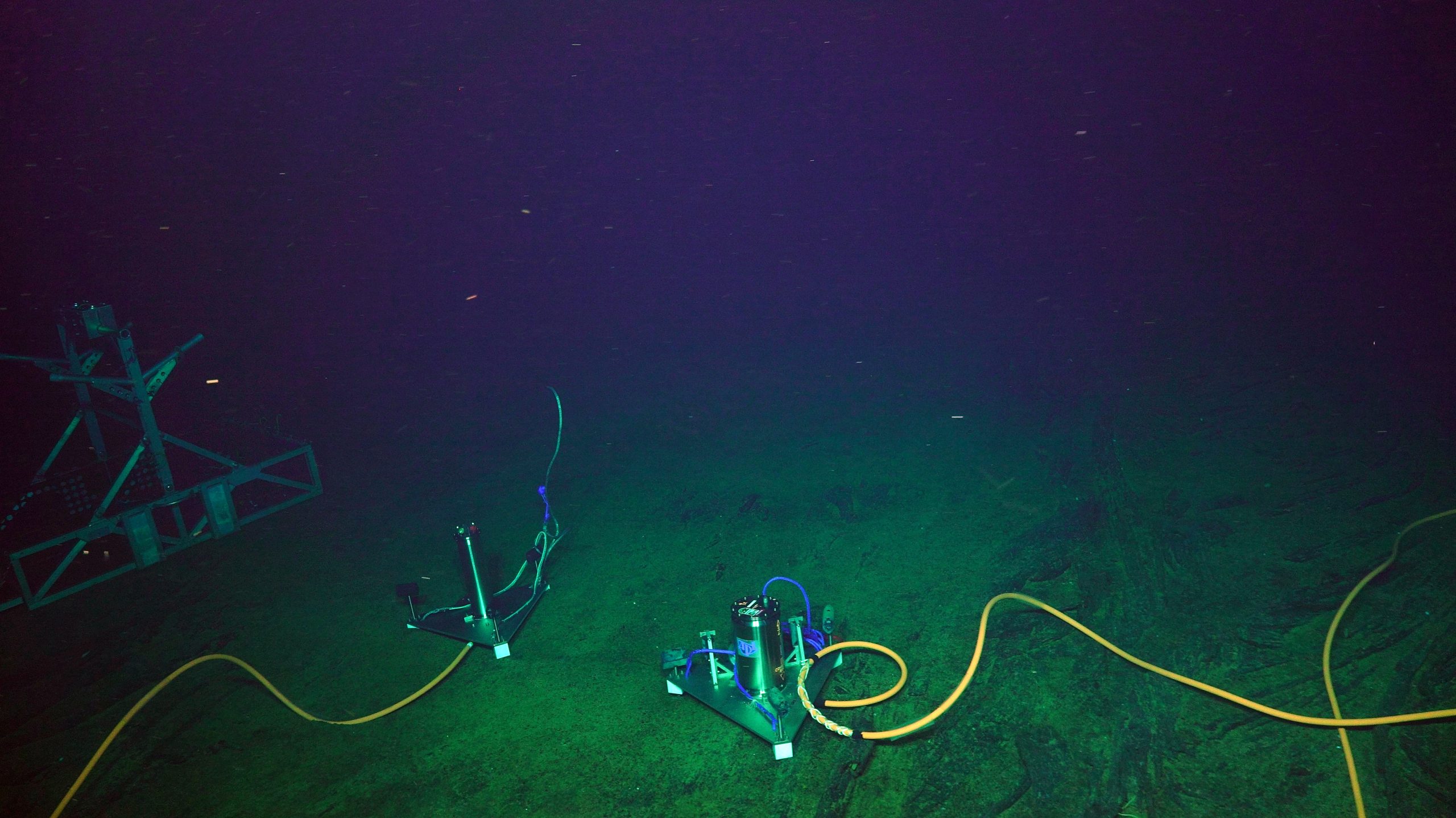 The NSF-funded Flipping Tilt Meter (right) and A-O-A instrument in 2019. The A-0-A instrument was moved to be adjacent to the Self Calibrating Pressure Recorder. Credit: UW/NSF-OOI/WHOI; V19.[/caption]
The NSF-funded Flipping Tilt Meter (right) and A-O-A instrument in 2019. The A-0-A instrument was moved to be adjacent to the Self Calibrating Pressure Recorder. Credit: UW/NSF-OOI/WHOI; V19.[/caption]
These three instruments and the OOI bottom pressure-tilt instrument are all installed within 50 meters of each other, providing an unparalleled opportunity for cross comparison of the real-time continuous data. In addition to the geophysical suite of instruments, a CTD instrument will be installed at this site in 2021 (see below; Dr. W. Chadwick, Oregon State University).
ASHES Vent Field
[caption id="attachment_20229" align="alignleft" width="243"]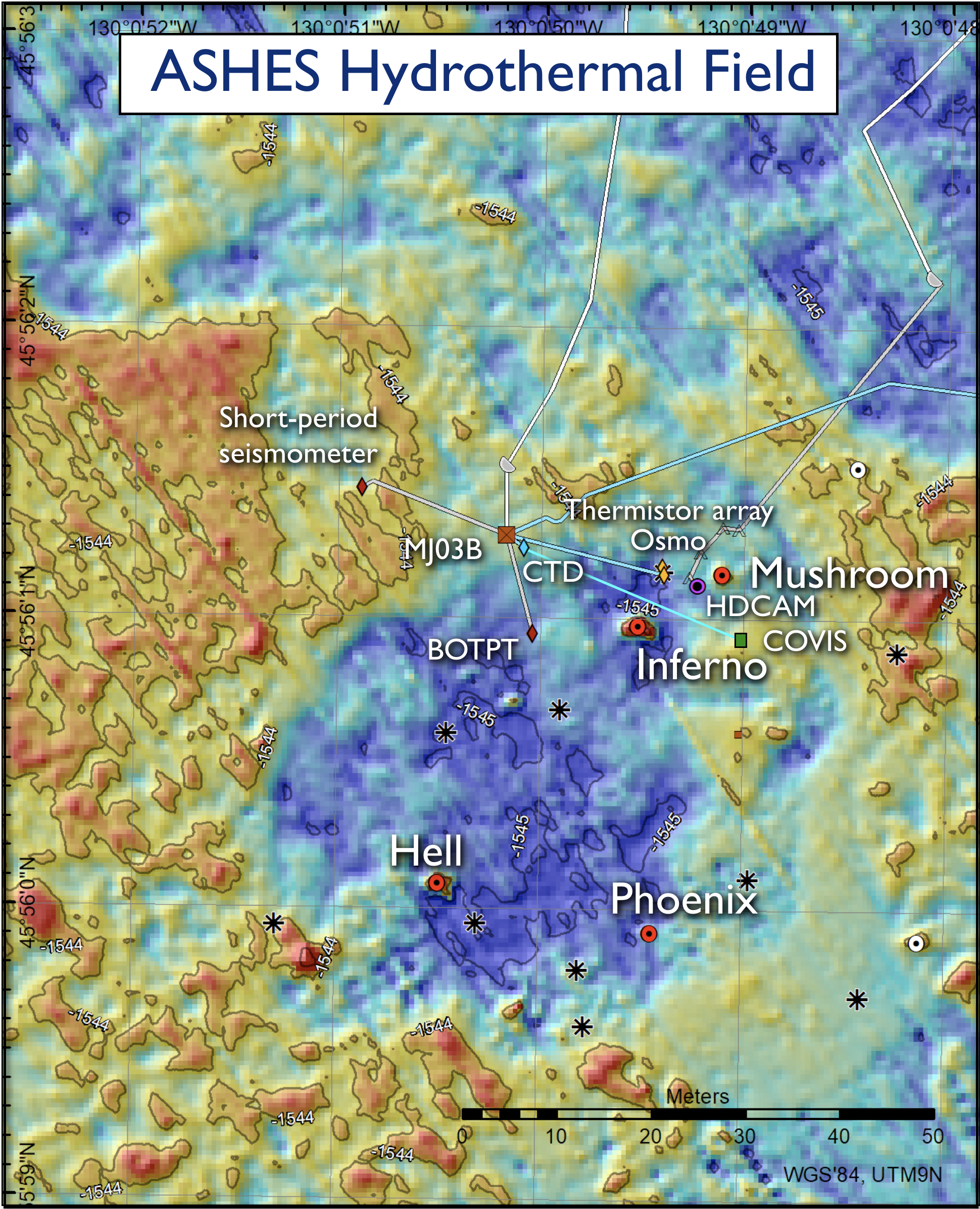 Regional Cabled Array infrastructure at ASHES in 2019. Also shown are the PI NSF-funded instruments (COVIS and CTD) and the location of high temperature vents (red dots) Credit: University of Washington.[/caption]
Regional Cabled Array infrastructure at ASHES in 2019. Also shown are the PI NSF-funded instruments (COVIS and CTD) and the location of high temperature vents (red dots) Credit: University of Washington.[/caption]
The ASHES vent field, located near the western wall of Axial Seamount, is a site focused on investigating the impacts of seismicity on fluid flow, quantitative measurement of the flux of fluids and heat from vents, evolution of sulfide chimneys and biological communities, and development of instrumentation for life detection.
Here, RCA core infrastructure includes an HD video camera imaging the actively-venting, animal-covered edifice called ‘Mushroom’ – live streaming of video occurs every three hours for ~ 14 minutes daily, two times a month for 24 hours, and once a month for 72 hours. In addition, there are two short-period seismometers located ~20 meters and 1200 meters from the field, a bottom pressure-tilt instrument, and a novel 3D temperature array with 24 sensors that is co-installed with an osmotic fluid sampler for time-series chemical measurement of diffuse flow.
PI- provided instruments at ASHES include an NSF-funded CTD installed in August 2017 (Dr. W. Chadwick, Oregon State University), which is one of three located within the caldera of Axial Seamount to investigate the emission of subsurface brines from the seafloor (Xu et al., 2018). Another CTD was installed in 2020 on the Eastern Caldera junction box. These data are available through OOI.
An NSF-funded cabled multibeam sonar system (COVIS – Cabled Observatory Vent Imaging Sonar – Dr. K. Bemis, Rutgers University) that was installed in 2018, which has resulted in the first long-term, quantitative monitoring of plume emissions.
[caption id="attachment_20228" align="alignleft" width="300"]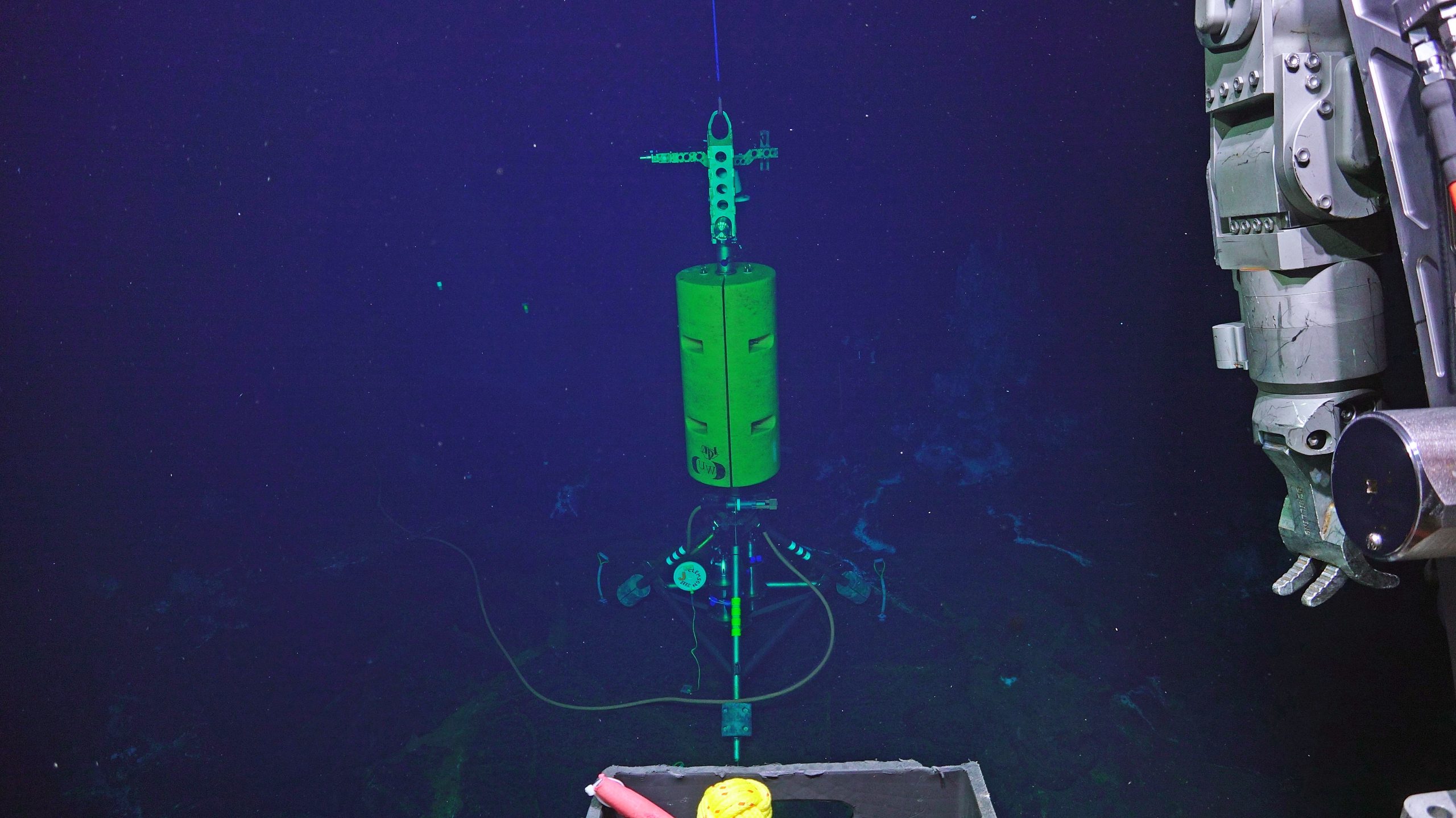 The COVIS sonar platform as installed in 2019 in the ASHES Hydrothermal Field. The sonar is focused on plume emissions and diffuse flow proximal to the hydrothermal chimneys Mushroom and Inferno. Credit: K. Bemis/Rutgers/UW/NSF/WHOI; V19.[/caption]
The COVIS sonar platform as installed in 2019 in the ASHES Hydrothermal Field. The sonar is focused on plume emissions and diffuse flow proximal to the hydrothermal chimneys Mushroom and Inferno. Credit: K. Bemis/Rutgers/UW/NSF/WHOI; V19.[/caption]
This platform stands over 4 m above the seafloor and images plumes proximal to the actively venting ‘Inferno’ and Mushroom chimney located 10 m away, as well as sites of diffuse flow. Sonar data coupled with in situ thermal measurements document significant changes in plume variations, and modeling results indicate a heat flux of 10 MW for the Inferno plume (Xu et al., 2020). Multibeam data and data products are available through OOI. COVIS will provide key data to the community investigating the impacts of eruptions on hydrothermal flow. A NASA-funded and cabled state-of-the-art platform called InVADER (In-situ Vent Analysis Divebot for Exobiology Research; P. Sobron, SETI Institute) hosting a spectroscopic laser and 3D imaging system will be installed in 2021 on the south side of Inferno. The purpose of this award is to advance technologies, real-time sensing, and mission execution applications in hydrothermal systems to further exploration and the study of vent environments on other ocean worlds.
[caption id="attachment_20237" align="alignright" width="246"]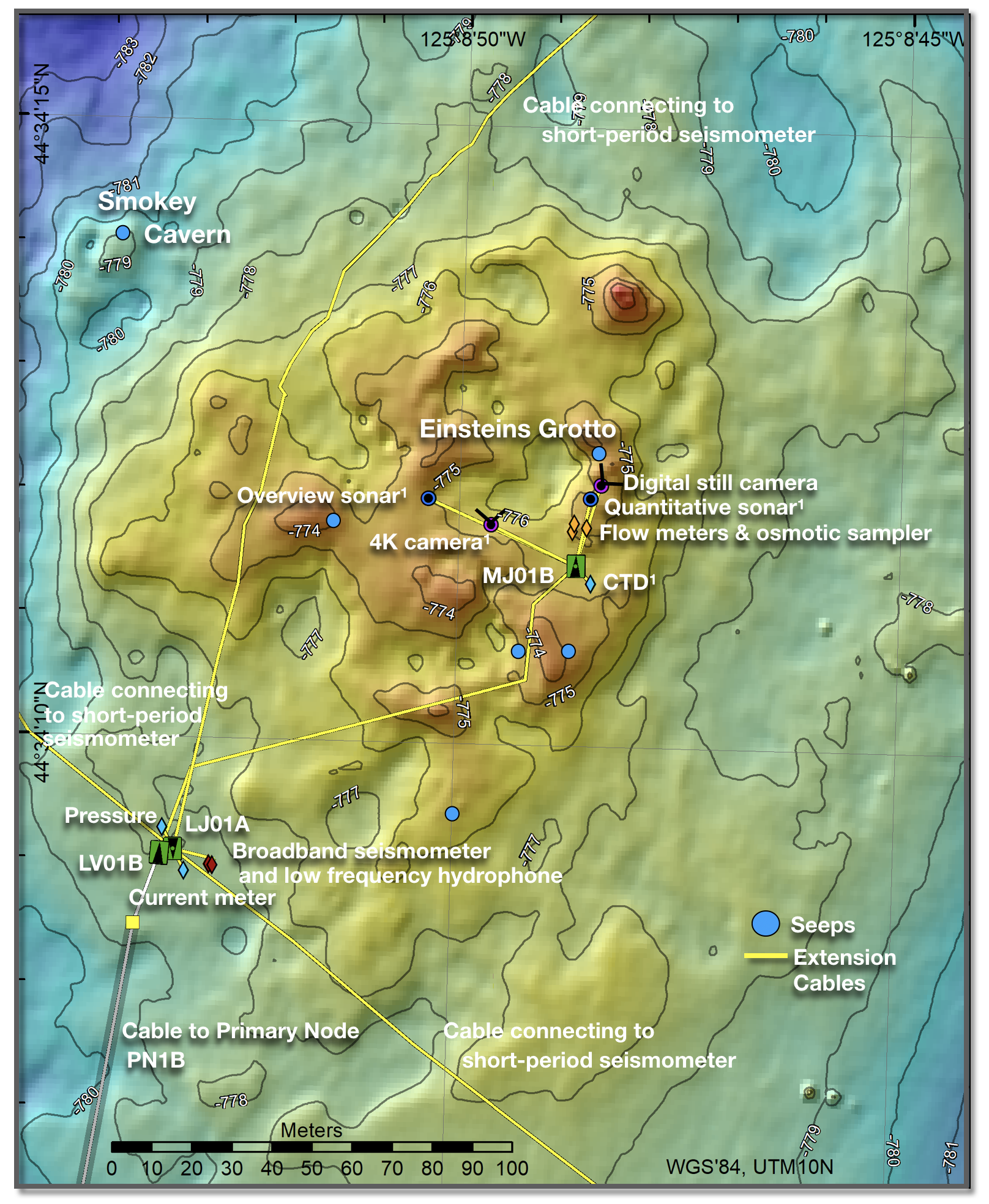 RCA infrastructure at Southern Hydrate Ridge as installed in 2019. Also shown are instruments funded by MARUM (2 sonars, 4K camera, and a CTD). Credit: University of Washington.[/caption]
RCA infrastructure at Southern Hydrate Ridge as installed in 2019. Also shown are instruments funded by MARUM (2 sonars, 4K camera, and a CTD). Credit: University of Washington.[/caption]
Southern Hydrate Ridge: Methane Ice, Seafloor Collapse and Dynamic Plumes
The cabled Southern Hydrate Ridge (SHR) site is one of the best studied methane hydrate systems in the oceans and it has been designated as an essential fish habitat. RCA infrastructure installed at the summit of the ridge includes a suite of 11 instruments to investigate the evolution of this highly dynamic system hosting multiple sites of bubble emission from the seafloor; a rapidly evolving topography marked by extremely hummocky terrain and rapidly forming collapse pits; and, at times, exposed hydrate on the seafloor. An array of short-period seismometers and a buried broadband seismometer provide real-time data on far-field and local seismicity. One goal for the triangular array of seismometers was to inform on subsurface plumbing through bubble formation.
Since 2014, Einstein’s Grotto has been the focused RCA experimental site hosting a digital still camera, flow meters, an osmotic fluid sampler, mass spectrometer, and an ADCP for imaging of the plume. Einstein’s Grotto is currently unrecognizable from when first surveyed, having transformed from a gentle hummock to a large collapse pit from which explosions of bubbles and entrained flocculant and sediment occurred in 2011, partial collapse of the pit in 2015, and, most recently, a much more subdued topography in 2020. Exposed methane hydrate within the pit has been viewed here on multiple cruises. Over the decade of imaging during RCA cruises, there has also been a dramatic change in the location, density, and thickness of bacterial mats around this area.
[caption id="attachment_20238" align="alignleft" width="214"]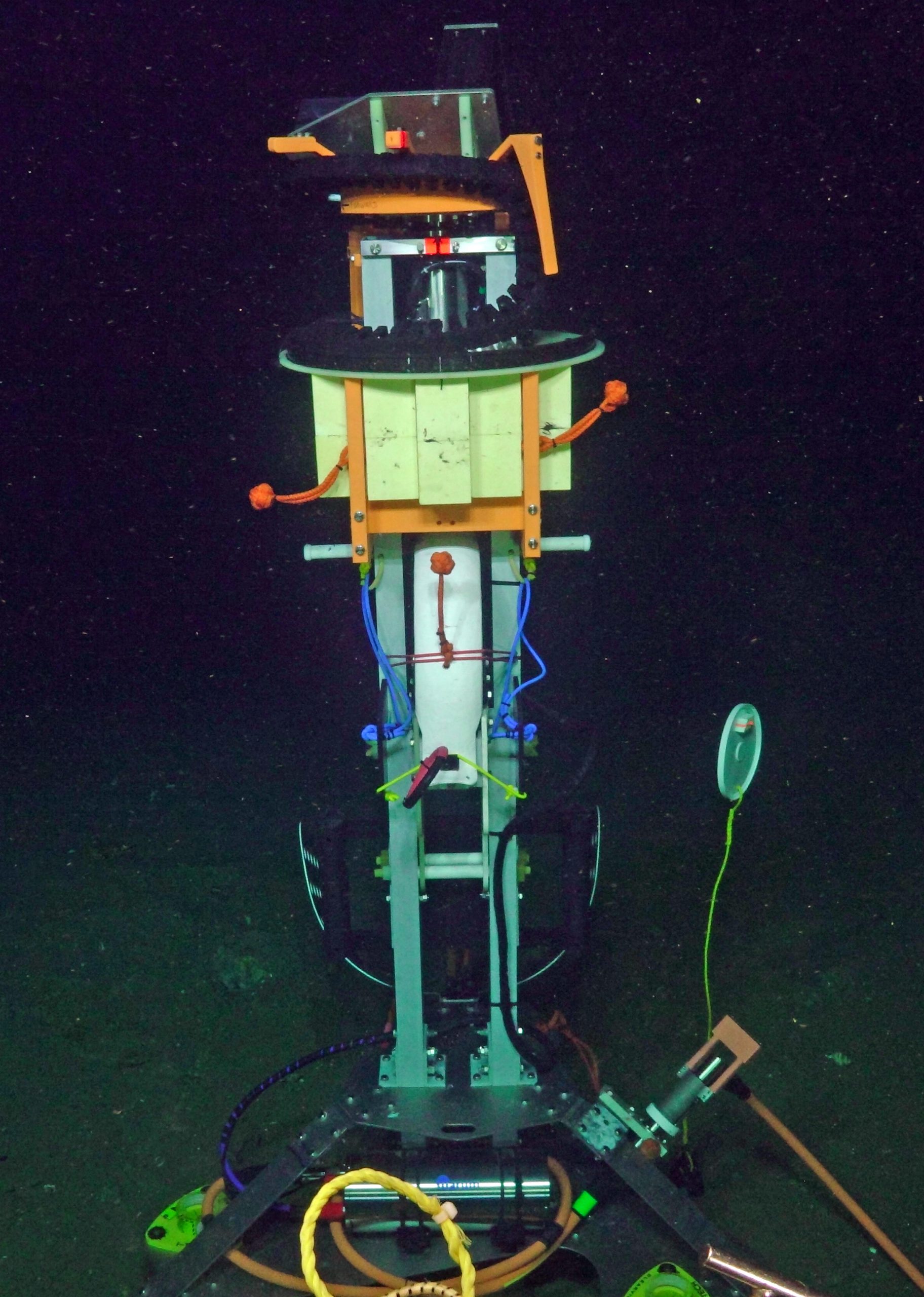 This rotating overview sonar (R2Sonic 2022) provides 360° imaging of all bubble plumes issuing from the summit of Southern Hydrate Ridge. Credit: MARUM/UW/WHOI; V18.[/caption]
This rotating overview sonar (R2Sonic 2022) provides 360° imaging of all bubble plumes issuing from the summit of Southern Hydrate Ridge. Credit: MARUM/UW/WHOI; V18.[/caption]
In 2018, a multi-year program “Sonar Monitoring of Natural Release of Methane Greenhouse Gas from the Seafloor – A Contribution to the Understanding of Global Change” funded by the German Ministry of Education and Research (Drs. G. Bohrmann and Y. Marcon, University of Bremen) resulted in the installation of instruments at SHR to quantify the flux of methane and bubble plume dynamics at this site. A ~3.6-meter-tall platform hosting a rotating multibeam sonar provides a 700 m across, 360° view of all bubble plumes emitted at the summit including their intensity and rise height. Scans are conducted about two hours apart. Also installed was a quantification sonar aimed at measuring gas flux and changes in seafloor topography proximal to Einstein’s Grotto. The quantification sonar is on a 2.6-meter-tall tripod that conducts 360° scans of the local water column. In 2019, this infrastructure was augmented by the addition of a cabled 4K camera and CTD. All instruments were recovered in 2020 and will be reinstalled in 2021.
[caption id="attachment_20239" align="alignright" width="300"]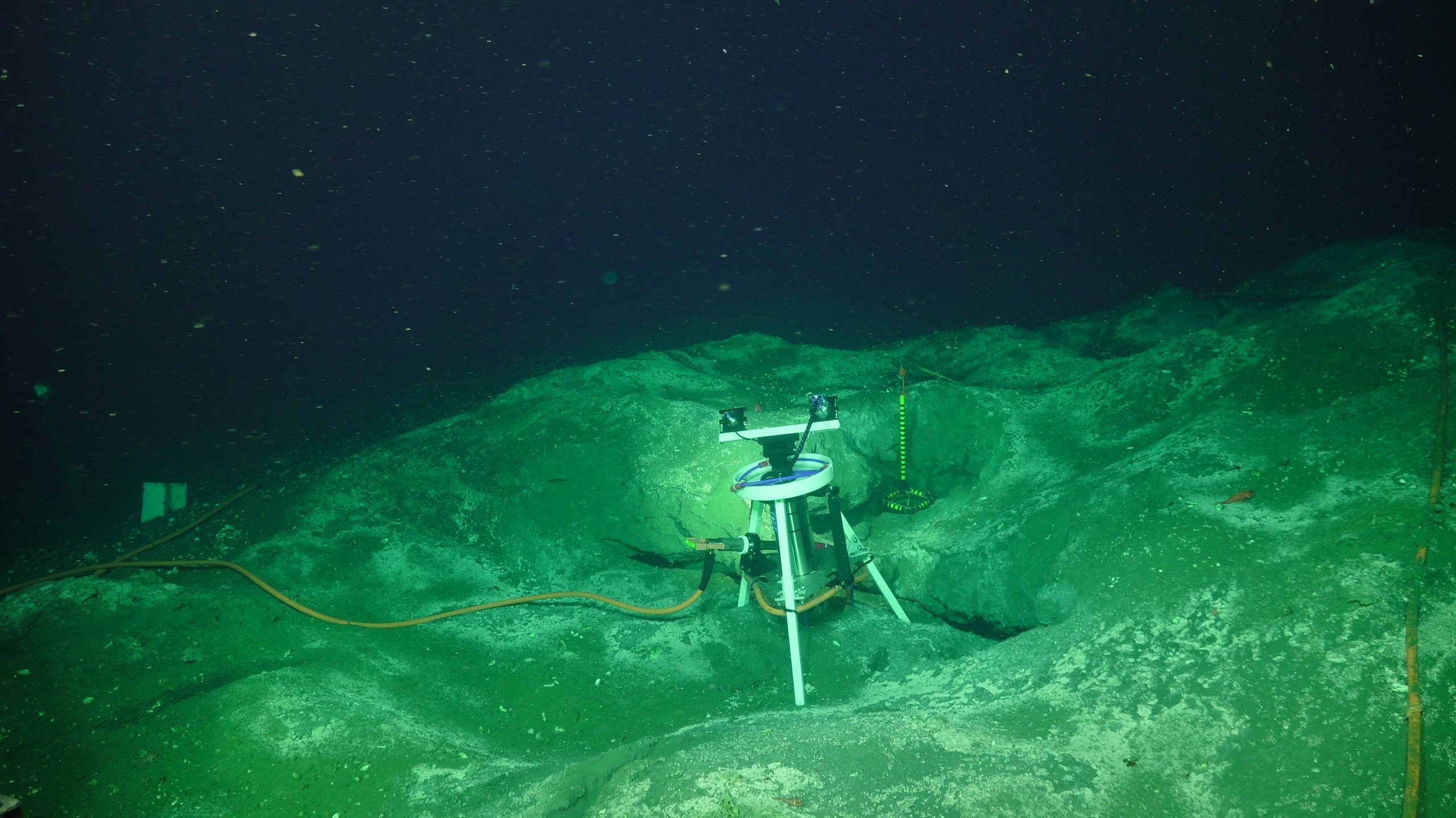 This 4K camera is focused on imaging the area proximal to Einstein’s Grotto. The area has changed remarkably over the past decade. Credit: MARUM/UW/WHOI; V19.[/caption]
This 4K camera is focused on imaging the area proximal to Einstein’s Grotto. The area has changed remarkably over the past decade. Credit: MARUM/UW/WHOI; V19.[/caption]
From 2019-2020, an uncabled microbial fuel cell (CH4-Benthic Observer Platform), funded by the Office of Naval Research, was installed on a microbial mat near Einstein’s Grotto, which included two osmotic fluid samplers (Dr. C. Reimers, Oregon State University). Finally, a new NSF award “Collaborative Research: Investigating the source and flux of dissolved organic carbon released from methane seeps to the deep ocean (Dr. L. Lapham, University of Maryland Center for Environmental Sciences) will result in the deployment of additional osmotic fluid samplers for continuous sampling of SHR seep fluids.
During the initial planning stages of the RCA, a key requirement in the design was to include significant expansion capabilities and power. In four years, the need for this requirement has been clearly demonstrated by the significant response from the community. At the 2016 OOI Design and Implementation Workshop in Salt Lake City, Utah, Dr. Margaret Leinen (Scripps Institution of Oceanography and University of California San Diego), then Associate Director for Geosciences, gave the keynote talk. In this presentation, she said “If you build it, they will come”…a prediction that has come to fruition with innovative and synergistic research into deep ocean processes focused on the cabled array.
This article was written by Deborah Kelley, Principal Investigator for the Regional Cabled Array.
Read More
Regional Cabled Array 2019 Expedition Sets Records
This summer’s Regional Cabled Array (RCA) 44-day expedition (May 30-July 12, 2019) onboard the R/V Atlantis was highly successful with the completion of all tasks scheduled for this annual maintenance and operations cruise. One hundred forty-nine out of 151 RCA Core and PI instruments are operational, all three instrumented Deep Profiler vehicles and instrumented Science Pods on the Shallow Profiler Moorings are conducting daily traverses through the water column, and 113 RCA instruments were installed. It was wonderful to once again see the beautiful life inhabiting the hydrothermal vents at Axial Seamount, amazing aggregations of cod curious about our work at the Oregon Offshore site, and to witness the profound changes that have taken place again at the methane seeps at Southern Hydrate Ridge.
During the 53 days of staging and demobing for the cruise over the four legs 166 tons of RCA equipment were transported to/from Seattle, WA and Newport, OR. Onboard staffing included 52 personnel with 13 students, six non-OOI PI’s-technicians from four institutions and one member from industry. In addition, Susan Casey, a New York Times bestselling author (i.e. The WAVE, the Devils Teeth, and Voices of the Ocean) participated on Leg 4. As part of the NSF Oceans Month, a 1-hour “Science in the Deep” Facebook live interactive broadcast was conducted, including live streaming of imagery from Jason working at Southern Hydrate Ridge and a period for questions and answers. There were 58 Jason Dives, with a record setting 20 dives in five days including deep dives to 2600 m and 2900 m water depths. The vehicle worked extremely well with turn-arounds commonly less than one hour.
Another big success for this summer occurred during nine days of at-sea operations dedicated to turning and installation of cabled and uncabled instrumentation and field work provided to externally-funded researchers. This work included the:
- Installation of an NSF-funded new high resolution, self-calibrating pressures sensor at Central Caldera, Axial Seamount (W. Wilcock, University of Washington).
- The recovery, repair and reinstallation of the NSF-funded COVIS multibeam sonar for hydrothermal plume imaging at the ASHES hydrothermal field, as well as installation of a thermistor array (K. Bemis, Rutgers University); Bemis also conducted a several hour thermal and video survey of the field.
- The turning of an NSF-funded CTD at the ASHES hydrothermal field, Axial Seamount (W. Chadwick, Oregon State University). Note Chadwick received a new NSF award to expand the CTD network to monitor the release of subsurface brines associated with eruptions at Axial as observed during the 2015 eruption (see Xu et al., 2018).
- The recovery of an ONR-funded uncabled Benthic Observatory Platform (BOP) from the Oregon Offshore site and installation of another BOP at a seep site at Southern Hydrate Ridge (C. Reimers-Oregon State University and P. Girguis-Harvard University) and associated sediment sampling; and
- The recovery, repair, and reinstallation of a University of Bremen-Germany-funded cabled overview multibeam sonar for imaging of all methane plumes at Southern Hydrate Ridge (G. Bohrmann and Y. Marcon -University of Bremen) – the range of this sonar is now extended from 200 m to 700 m. A new 4K video-still camera was also installed near Einsteins’ Grotto.
The RCA engineering and science team is enjoying being on land after conducting round the clock operations to insure that the facility work was completed on schedule. Folks are enjoying the Seattle sun and the Cascades and Olympic mountains during the summer blue-skied days. Soon however, our thoughts, will be turning to refurbishment and planning for next years cruise. The team is looking forward to working with the VISIONS19 students on their projects this upcoming academic year; we are excited to see the stories they tell with new eyes focusing on the oceans, the RCA, and OOI.
Read MoreStreaming Live From the Deep: The 2019 OOI Regional Cabled Array expedition
This summer’s exciting sea-going expedition in the Northeast Pacific to maintain the National Science Foundation’s Ocean Observatories Initiative Regional Cabled Observatory is underway, and you can join us at InteractiveOceans.
Over the next several weeks, the University of Washington Cabled Array team will be adding novel sensors that allow a global audience to watch live the daily deformation and seismic activity at the largest underwater volcano off our coast, Axial Seamount. Axial erupted in 2015 and is poised to do so again. In addition, we will be adding new instruments, including a 4K video camera aimed at a highly dynamic methane seep site off Newport, Oregon, called Southern Hydrate Ridge, where streams of bubbles issue from the seafloor daily.
[media-caption type="image" path="https://oceanobservatories.org/wp-content/uploads/2019/06/AtlantisBackdeck_1_small-1080.jpg" link="#"]R/V Atlantis steams back to shore after Leg 1 of the 2019 Regional Cabled Array cruise, following the successful installation of the Shallow Profiler Mooring at Axial Base. Photo by J. Tilley, University of Washington[/media-caption]The cruise, which departed June 2 and continues until July 12, is using the remotely operated vehicle (ROV) Jason onboard the R/V Atlantis operated by Woods Hole Oceanographic Institution. Nineteen U.S. and international undergraduate students are working side-by-side scientists, engineers, ROV team, and ship’s crew on the expedition as part of the UW experiential at-sea VISIONS program.
This expedition is highly complex with a diverse array of more than100 instruments, junction boxes, and instrumented pods on the Shallow Profiler Moorings that will be recovered, installed, and tested. R/V Atlantis will be “packed to the gills” on each of the four legs that make up this expedition, carrying everything from state-of-the-art mooring components to sharpies.
Starting around June 12 or 13, you will be able to watch our underwater operations live through streaming video as ROV Jason works more than 300 miles offshore and 5,000 feet below the surface down at the summit of Axial Seamount, which hosts 350°C (660°F) deep-sea hot springs that support some of the most bizarre creatures on Earth. We will also be 250 miles off Newport in depths ranging from 250 feet to 10,000 feet in some of the most biologically productive waters in the world and at sedimented sites on the Cascadia margin where methane-rich plumes jet from the seafloor. There, methane seeps support dense bacterial mats and large clams that thrive in the absence of sunlight on gases pouring from the seafloor.
A 4K camera funded by the University of Bremen will provide real-time views of the methane plumes and seafloor life to document this incredibly dynamic environment marked by large explosion pits and collapse basins. This is the second year of this international collaboration that expands the capability of the Regional Cabled Array and provides new imagery of these dynamic systems for all to see.
An enhanced, high-bandwidth satellite connection from R/V Atlantis will allow you to experience our deep-sea operations through daily live video streams. It will also allow onboard engineers and scientists to see data for the first time as new instruments are connected to the seafloor submarine fiber optic cables that bring the global Internet into the oceans. So tune in and see what we see when we see it.
Read More

